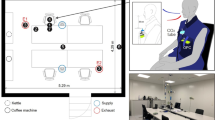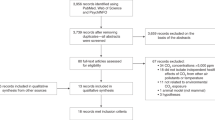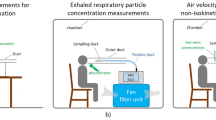Abstract
Inhalation exposure to pure and metabolic elevated carbon dioxide (CO2) concentration has been associated with impaired work performance, lower perceived air quality, and increased health symptoms. In this study, the concentration of metabolic CO2 was continuously measured in the inhalation zone of 41 subjects performing simulated office work. The measurements took place in an environmental chamber with well-controlled mechanical ventilation arranged as an office environment. The results showed the existence of a personal CO2 cloud in the inhalation zone of all test subjects, characterized by the excess of metabolic CO2 beyond the room background levels. For seated occupants, the median CO2 inhalation zone concentration levels were between 200 and 500 ppm above the background, and the third quartile up to 800 ppm above the background. Each study subject had distinct magnitude of the personal CO2 cloud owing to differences in metabolic CO2 generation, posture, nose geometry, and breathing pattern. A small desktop oscillating fan proved to be suitable for dispersing much of the personal CO2 cloud, thus reducing the inhalation zone concentration to background level. The results suggest that background measurements cannot capture the significant personal CO2 cloud effect in human microclimate.
This is a preview of subscription content, access via your institution
Access options
Subscribe to this journal
Receive 6 print issues and online access
$259.00 per year
only $43.17 per issue
Buy this article
- Purchase on Springer Link
- Instant access to full article PDF
Prices may be subject to local taxes which are calculated during checkout






Similar content being viewed by others
References
Satish U, Mendell MJ, Shekhar K, Hotchi T, Sullivan D, Streufert S, et al. Is CO2 an indoor pollutant? Direct effects of low-to-moderate CO2 concentrations on human decision-making performance. Environ Health Perspect. 2012;120:1671–7.
Allen JG, MacNaughton P, Satish U, Santanam S, Vallarino J, Spengler JD. Associations of cognitive function scores with carbon dioxide, ventilation, and volatile organic compound exposures in office workers: a controlled exposure study of green and conventional office environments. Environ Health Perspect. 2016;124:805–12.
MacNaughton P, Spengler J, Vallarino J, Santanam S, Satish U, Allen J. Environmental perceptions and health before and after relocation to a green building. Build Environ. 2016;104:138–44.
Allen JG, MacNaughton P, Cedeno-Laurent JG, Cao X, Flanigan S, Vallarino J, et al. Airplane pilot flight performance on 21 maneuvers in a flight simulator under varying carbon dioxide concentrations. J Expo Sci Environ Epidemiol. 2018. https://doi.org/10.1038/s41370-018-0055-8.
Wargocki P, Wyon DP, Sundell J, Clausen G, Fanger PO. The effects of outdoor air supply rate in an office on perceived air quality, sick building syndrome (SBS) symptoms and productivity. Indoor Air. 2000;10:222–36.
Zhang X, Wargocki P, Lian Z. Human responses to carbon dioxide, a follow-up study at recommended exposure limits in non-industrial environments. Build Environ. 2016;100:162–71.
Fisk WJ, Rosenfeld AH. Estimates of improved productivity and health from better indoor environments. Indoor Air. 1997;7:158–72.
Fisk WJ, E. P, Member ASHRAE. How IEQ affects health, Productivity. http://doas-radiant.psu.edu/fisk.pdf.
Klepeis NE, Nelson WC, Ott WR, Robinson JP, Tsang AM, Switzer P, et al. The national human activity pattern survey (NHAPS): a resource for assessing exposure to environmental pollutants. J Expo Anal Environ Epidemiol. 2001;11:231–52.
McBride SJ, Ferro AR, Ott WR, Switzer P, Hildemann LM. Investigations of the proximity effect for pollutants in the indoor environment. J Expo Anal Environ Epidemiol. 1999;9:602–21.
Klepeis NE, Gabel EB, Ott WR, Switzer P. Outdoor air pollution in close proximity to a continuous point source. Atmos Environ. 2009;43:3155–67.
Long CM, Suh HH, Koutrakis P. Characterization of indoor particle sources using continuous mass and size monitors. J Air Waste Manag Assoc. 2000;50:1236–50.
Nazaroff WW, Weschler CJ. Cleaning products and air fresheners: exposure to primary and secondary air pollutants. Atmos Environ. 2004;38:2841–65.
Bhangar S, Adams RI, Pasut W, Huffman JA, Arens EA, Taylor JW, et al. Chamber bioaerosol study: human emissions of size-resolved fluorescent biological aerosol particles. Indoor Air. 2016;26:193–206.
Licina D, Tian Y, Nazaroff WW. Emission rates and the personal cloud effect associated with particle release from the perihuman environment. Indoor Air. 2017;27:791–802.
Licina D, Nazaroff WW. Clothing as a transport vector for airborne particles: Chamber study. Indoor Air. 2018;28:404–14.
Tang X, Misztal PK, Nazaroff WW, Goldstein AH. Volatile organic compound emissions from humans indoors. Environ Sci Technol. 2016;50:12686–94.
Liu S, Li R, Wild RJ, Warneke C, de Gouw JA, Brown SS, et al. Contribution of human-related sources to indoor volatile organic compounds in a university classroom. Indoor Air. 2016;26:925–38.
Corsi RL, Siegel J, Karamalegos A, Simon H, Morrison GC. Personal reactive clouds: Introducing the concept of near-head chemistry. Atmos Environ. 2007;41:3161–5.
Rim D, Novoselec A, Morrison G. The influence of chemical interactions at the human surface on breathing zone levels of reactants and products. Indoor Air. 2009;19:324–34.
Persily A, de Jonge L. Carbon dioxide generation rates for building occupants. Indoor Air. 2017;27:868–79.
Melikov A, Kaczmarczyk J. Measurement and prediction of indoor air quality using a breathing thermal manikin. Indoor Air. 2007;17:50–9.
Pantelic J, Rysanek A, Miller C, Peng Y, Teitelbaum E, Meggers F, et al. Comparing the indoor environmental quality of a displacement ventilation and passive chilled beam application to conventional air-conditioning in the Tropics. Build Environ. 2018;130:128–42.
Pantelic J, Webster T, Heinzerling D, Paliaga G. IoT tools for assessing building operation. ASHRAE J. 2018;60:73–5.
Ghahramani A, Pantelic J, Vannucci M, Pistore L, Liu S, Gilligan B, et al. Personal CO2 bubble: context-dependent variations and wearable sensors usability. J Build Eng. 2019;22:295–304.
Laverge J, Spilak M, Novoselac A. Experimental assessment of the inhalation zone of standing, sitting and sleeping persons. Build Environ. 2014;82:258–66.
Brohus H, Nielsen PV. Personal exposure in displacement ventilated rooms. Indoor Air. 1996;6:157–67.
Pantelic J, Sze-To GN, Tham KW, Chao CYH, Khoo YCM. Personalized ventilation as a control measure for airborne transmissible disease spread. J R Soc Interface. 2009;6:S715–26.
Tham KW, Pantelic J. Performance evaluation of the coupling of a desktop personalized ventilation air terminal device and desk mounted fans. Build Environ. 2010;45:1941–50.
Pantelic J, Tham KW, Licina D. Effectiveness of a personalized ventilation system in reducing personal exposure against directly released simulated cough droplets. Indoor Air. 2015;25:683–93.
Licina D, Melikov A, Pantelic J, Sekhar C, Tham KW. Human convection flow in spaces with and without ventilation: personal exposure to floor-released particles and cough-released droplets. Indoor Air. 2015;25:672–82.
Licina D, Pantelic J, Melikov A, Sekhar C, Tham KW. Experimental investigation of the human convective boundary layer in a quiescent indoor environment. Build Environ. 2014;75:79–91.
Gupta JK, Lin C-H, Chen Q. Characterizing exhaled airflow from breathing and talking. Indoor Air. 2010;20:31–9.
Arens EA, Zhang H, Kim D, Buchberger E, Bauman F, Huizenga C, et al. Impact of a task-ambient ventilation system on perceived air quality. 2008. https://escholarship.org/uc/item/5st3f0dp.
Melikov AK, Kaczmarczyk J. Air movement and perceived air quality. Build Environ. 2012;47:400–9.
Schiavon S, Yang B, Donner Y, Chang VW-C, Nazaroff WW. Thermal comfort, perceived air quality, and cognitive performance when personally controlled air movement is used by tropically acclimatized persons. Indoor Air. 2017;27:690–702.
Rudnick SN, Milton DK. Risk of indoor airborne infection transmission estimated from carbon dioxide concentration. Indoor Air. 2003;13:237–45.
Wargocki P, Seppanen O, Andersson J, Boestra A, Clements-Croome D, Fitzner K, et al. Indoor climate and productivity in offices. How to integrate productivity in life cycle costs analysis of building services. REHVA Guidebook. 2006.
Gao Y, Zhang H, Arens E, Present E, Ning B, Zhai Y, et al. Ceiling fan air speeds around desks and office partitions. Build Environ. 2017;124:412–40.
Liu S, Lipczynska A, Schiavon S, Arens E. Detailed experimental investigation of air speed field induced by ceiling fans. Build Environ. 2018;142:342–60.
Lipczynska A, Schiavon S, Graham LT. Thermal comfort and self-reported productivity in an office with ceiling fans in the tropics. Build Environ. 2018;135:202–12.
Acknowledgements
This study was funded by the U.S. General Services Administration (GSA) under interagency agreement no. GX0012829 with the U.S. Department of Energy and Lawrence Berkeley National Laboratory. The authors wish to acknowledge the following members of GSA’s Wellbuilt for Wellbeing Group is a multidisciplinary research project team (GSA Contract # GS-00-H-14-AA-C-0094) consisting of the following members: Kevin Kampschroer, Judith Heerwagen and Brian Gilligan of GSA. Esther Sternberg, Perry Skeath, Casey Lindberg, and Matthias Mehlof the University of Arizona Institute on Place and Wellbeing. Bijan Najafi, Javad Razjouyan, Hyoki Lee, and Hung Nguyen of the Baylor College of Medicine Interdisciplinary Consortium on Advanced Motion Performance (iCAMP). Sudha Ram, Faiz Curim and Karthik Srinivasian of the University of Arizona INSITE Center for Business Intelligence and Analytics. Kelly Canada of LMI Inc. Priya Saha, Rebecca Goldfinger-Fein, Alicia Darbishire, and Mills Wallace of the Federal Occupantional Health Service. Davida Herzl, Reuben Herzl, Melissa Lunden, Nicole Goebel, and Scott Andrews of Aclima Inc.
This research was also partially supported by the Republic of Singapore’s National Research Foundation through a grant to the Berkeley Education Alliance for Research in Singapore (BEARS) for the Singapore-Berkeley Building Efficiency and Sustainability in the Tropics (SinBerBEST) Program.
Author information
Authors and Affiliations
Consortia
Corresponding author
Ethics declarations
Conflict of interest
The authors declare that they have no conflict of interest.
Additional information
Publisher’s note Springer Nature remains neutral with regard to jurisdictional claims in published maps and institutional affiliations.
Supplementary Information
Rights and permissions
About this article
Cite this article
Pantelic, J., Liu, S., Pistore, L. et al. Personal CO2 cloud: laboratory measurements of metabolic CO2 inhalation zone concentration and dispersion in a typical office desk setting. J Expo Sci Environ Epidemiol 30, 328–337 (2020). https://doi.org/10.1038/s41370-019-0179-5
Received:
Revised:
Accepted:
Published:
Issue Date:
DOI: https://doi.org/10.1038/s41370-019-0179-5
This article is cited by
-
Building performance simulations can inform IoT privacy leaks in buildings
Scientific Reports (2023)
-
Proxy methods for detection of inhalation exposure in simulated office environments
Journal of Exposure Science & Environmental Epidemiology (2023)
-
Development of a Bayesian inference model for assessing ventilation condition based on CO2 meters in primary schools
Building Simulation (2023)



